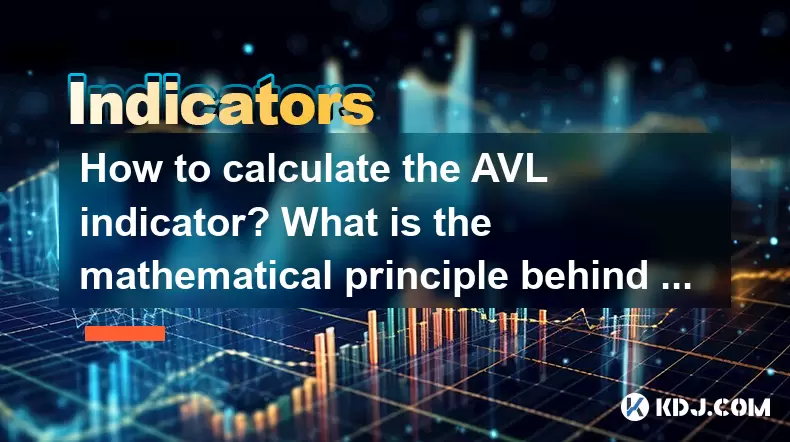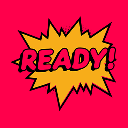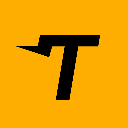-
 bitcoin
bitcoin $122288.232522 USD
0.16% -
 ethereum
ethereum $4480.662914 USD
-0.22% -
 xrp
xrp $2.962747 USD
-2.32% -
 tether
tether $1.000120 USD
-0.05% -
 bnb
bnb $1145.654223 USD
-2.07% -
 solana
solana $227.105217 USD
-1.67% -
 usd-coin
usd-coin $0.999548 USD
-0.02% -
 dogecoin
dogecoin $0.250875 USD
-2.04% -
 tron
tron $0.340654 USD
-0.49% -
 cardano
cardano $0.837968 USD
-2.52% -
 hyperliquid
hyperliquid $48.960449 USD
0.06% -
 chainlink
chainlink $22.049280 USD
-1.33% -
 ethena-usde
ethena-usde $1.000404 USD
0.02% -
 sui
sui $3.586212 USD
0.20% -
 avalanche
avalanche $29.894916 USD
-4.18%
How to calculate the AVL indicator? What is the mathematical principle behind it?
The AVL indicator, a moving average of trading volumes, helps crypto traders assess market trends and make informed decisions based on volume data.
May 22, 2025 at 01:35 am

The AVL (Average Volume Line) indicator is a popular tool used in the cryptocurrency trading community to assess the strength and direction of market trends by analyzing trading volumes. This indicator helps traders make informed decisions by providing insights into whether a trend is likely to continue or reverse. In this article, we will delve into the details of how to calculate the AVL indicator and explore the mathematical principles that underpin its functionality.
Understanding the AVL Indicator
The AVL indicator is essentially a moving average of trading volumes over a specified period. It smooths out volume data to provide a clearer picture of volume trends, which can be particularly useful in volatile markets like those of cryptocurrencies. By analyzing the AVL, traders can identify periods of high or low trading activity, which often precede significant price movements.
Calculating the AVL Indicator
To calculate the AVL indicator, you need to follow a straightforward process that involves summing up the trading volumes over a chosen period and then dividing by the number of periods. Here is a detailed step-by-step guide on how to do this:
- Choose the Time Frame: Decide on the time frame over which you want to calculate the AVL. Common periods include 10, 20, or 50 days, but this can be adjusted based on your trading strategy.
- Gather Volume Data: Collect the trading volume data for each period within your chosen time frame. This data is readily available on most cryptocurrency trading platforms.
- Sum the Volumes: Add up the trading volumes for all periods within your chosen time frame.
- Calculate the Average: Divide the total sum of volumes by the number of periods to get the average volume over the specified time frame.
Here is an example to illustrate this process:
- Suppose you choose a 10-day time frame.
- The trading volumes for the past 10 days are: 100, 150, 200, 250, 300, 350, 400, 450, 500, 550.
- Sum these volumes: 100 + 150 + 200 + 250 + 300 + 350 + 400 + 450 + 500 + 550 = 3050.
- Divide by the number of periods (10 days): 3050 / 10 = 305.
Thus, the AVL for this 10-day period is 305.
Mathematical Principles Behind the AVL Indicator
The AVL indicator is rooted in the principles of moving averages, which are statistical tools used to analyze data points by creating a series of averages of different subsets of the full data set. The mathematical principle behind the AVL indicator can be expressed as follows:
[ \text{AVL} = \frac{\sum_{i=1}^{n} V_i}{n} ]
Where:
- ( V_i ) represents the trading volume for the ( i )-th period.
- ( n ) is the number of periods over which the AVL is calculated.
This formula is a simple arithmetic mean, which is a fundamental concept in statistics. The use of a moving average in the AVL indicator helps to smooth out short-term fluctuations and highlight longer-term trends in trading volumes.
Using the AVL Indicator in Cryptocurrency Trading
The AVL indicator can be a valuable tool for cryptocurrency traders looking to gauge market sentiment and potential price movements. Here are some ways traders use the AVL indicator:
- Trend Confirmation: If the AVL is rising, it suggests increasing market activity and potentially a strengthening trend. Conversely, a declining AVL may indicate waning interest and a possible trend reversal.
- Volume Divergence: Traders look for divergences between price and volume. For instance, if prices are rising but the AVL is falling, it might signal a weakening trend and a potential price correction.
- Breakout Confirmation: When a cryptocurrency breaks out of a consolidation range, a corresponding increase in the AVL can confirm the strength of the breakout.
Implementing the AVL Indicator in Trading Platforms
Most cryptocurrency trading platforms and charting software allow traders to add the AVL indicator to their charts easily. Here’s how you can do it on a typical trading platform:
- Open the Charting Tool: Navigate to the charting section of your trading platform.
- Select the Indicator: Look for the indicator menu and select the moving average or volume indicator section.
- Configure the Settings: Choose the type of moving average (simple, exponential, etc.), and set the period to match your chosen time frame for the AVL.
- Apply to Chart: Once configured, apply the indicator to your chart. The AVL line will appear, representing the average volume over the specified period.
Interpreting the AVL Indicator
Interpreting the AVL indicator involves understanding the trends and patterns it reveals. Here are some key points to consider:
- Rising AVL: A rising AVL indicates increasing trading activity, which can signal strong market interest and potentially a continuation of the current trend.
- Falling AVL: A falling AVL suggests decreasing trading activity, which might indicate a loss of market interest and a possible trend reversal.
- Volume Spikes: Sudden spikes in the AVL can precede significant price movements, as they often reflect heightened market activity.
Practical Example of Using the AVL Indicator
Let's consider a practical example of how a trader might use the AVL indicator to make trading decisions:
- Suppose a trader is monitoring Bitcoin (BTC) and notices that the price has been steadily increasing over the past few weeks.
- The trader checks the AVL over a 20-day period and sees that it has been rising in tandem with the price.
- This rising AVL confirms the strength of the bullish trend, suggesting that the trader might want to consider entering a long position.
- However, if the price continues to rise but the AVL starts to decline, the trader might see this as a warning sign of a potential trend reversal and could decide to take profits or exit the position.
Frequently Asked Questions
Q1: Can the AVL indicator be used for all cryptocurrencies, or is it better suited for certain types?A1: The AVL indicator can be used for any cryptocurrency, as it is based on trading volume data, which is available for all cryptocurrencies. However, it may be more effective for cryptocurrencies with higher liquidity and trading volumes, as these tend to provide more reliable volume data.
Q2: How does the choice of time frame affect the AVL indicator's effectiveness?A2: The choice of time frame significantly impacts the AVL indicator's effectiveness. Shorter time frames, such as 10 days, provide more responsive signals but may be more susceptible to noise. Longer time frames, such as 50 days, offer smoother signals but may lag behind real-time market movements. Traders should choose a time frame that aligns with their trading strategy and risk tolerance.
Q3: Are there any common pitfalls to avoid when using the AVL indicator?A3: One common pitfall is over-relying on the AVL indicator without considering other factors. Volume data alone does not provide a complete picture of market conditions. Traders should use the AVL in conjunction with other indicators and market analysis tools to make well-informed decisions. Additionally, false signals can occur, especially in less liquid markets, so it's important to verify signals with additional data.
Q4: Can the AVL indicator be combined with other technical indicators for better results?A4: Yes, the AVL indicator can be effectively combined with other technical indicators to enhance trading strategies. For example, combining the AVL with moving average convergence divergence (MACD) or relative strength index (RSI) can provide a more comprehensive view of market trends and potential entry or exit points.
Disclaimer:info@kdj.com
The information provided is not trading advice. kdj.com does not assume any responsibility for any investments made based on the information provided in this article. Cryptocurrencies are highly volatile and it is highly recommended that you invest with caution after thorough research!
If you believe that the content used on this website infringes your copyright, please contact us immediately (info@kdj.com) and we will delete it promptly.
- BlockDAG, DOGE, HYPE Sponsorship: Crypto Trends Shaping 2025
- 2025-10-01 00:25:13
- Deutsche Börse and Circle: A StableCoin Adoption Powerhouse in Europe
- 2025-10-01 00:25:13
- BlockDAG's Presale Buzz: Is It the Crypto to Watch in October 2025?
- 2025-10-01 00:30:13
- Bitcoin, Crypto, and IQ: When Genius Meets Digital Gold?
- 2025-10-01 00:30:13
- Stablecoins, American Innovation, and Wallet Tokens: The Next Frontier
- 2025-10-01 00:35:12
- NBU, Coins, and Crypto in Ukraine: A New Yorker's Take
- 2025-10-01 00:45:14
Related knowledge

What is a tower bottom candlestick pattern? Does it have a high success rate?
Sep 22,2025 at 07:18am
Tower Bottom Candlestick Pattern Explained1. The tower bottom candlestick pattern is a reversal formation that typically appears at the end of a downt...

What is a black hole pattern in the MACD indicator? Is it a cause for concern?
Sep 21,2025 at 06:54pm
Bitcoin's Role in Decentralized Finance1. Bitcoin remains the cornerstone of decentralized finance, serving as a benchmark for value and security acro...

How can I use the psychological line (PSY) to determine market sentiment?
Sep 17,2025 at 02:19pm
Understanding the Psychological Line (PSY) in Cryptocurrency TradingThe Psychological Line, commonly referred to as PSY, is a momentum oscillator used...

How can I determine if a double top pattern has officially formed?
Sep 21,2025 at 03:18am
Understanding the Structure of a Double Top Pattern1. A double top pattern consists of two distinct peaks that reach approximately the same price leve...

What is the Golden Valley pattern on the moving average? Is it better than the Silver Valley pattern?
Sep 21,2025 at 02:54pm
Understanding the Golden Valley Pattern in Moving Averages1. The Golden Valley pattern is a technical formation observed in cryptocurrency price chart...

What does a death cross of the RSI in the strong zone (above 50) mean?
Sep 17,2025 at 10:54pm
Understanding the Death Cross in RSI Context1. The term 'death cross' is traditionally associated with moving averages, where a short-term average cro...

What is a tower bottom candlestick pattern? Does it have a high success rate?
Sep 22,2025 at 07:18am
Tower Bottom Candlestick Pattern Explained1. The tower bottom candlestick pattern is a reversal formation that typically appears at the end of a downt...

What is a black hole pattern in the MACD indicator? Is it a cause for concern?
Sep 21,2025 at 06:54pm
Bitcoin's Role in Decentralized Finance1. Bitcoin remains the cornerstone of decentralized finance, serving as a benchmark for value and security acro...

How can I use the psychological line (PSY) to determine market sentiment?
Sep 17,2025 at 02:19pm
Understanding the Psychological Line (PSY) in Cryptocurrency TradingThe Psychological Line, commonly referred to as PSY, is a momentum oscillator used...

How can I determine if a double top pattern has officially formed?
Sep 21,2025 at 03:18am
Understanding the Structure of a Double Top Pattern1. A double top pattern consists of two distinct peaks that reach approximately the same price leve...

What is the Golden Valley pattern on the moving average? Is it better than the Silver Valley pattern?
Sep 21,2025 at 02:54pm
Understanding the Golden Valley Pattern in Moving Averages1. The Golden Valley pattern is a technical formation observed in cryptocurrency price chart...

What does a death cross of the RSI in the strong zone (above 50) mean?
Sep 17,2025 at 10:54pm
Understanding the Death Cross in RSI Context1. The term 'death cross' is traditionally associated with moving averages, where a short-term average cro...
See all articles










































































